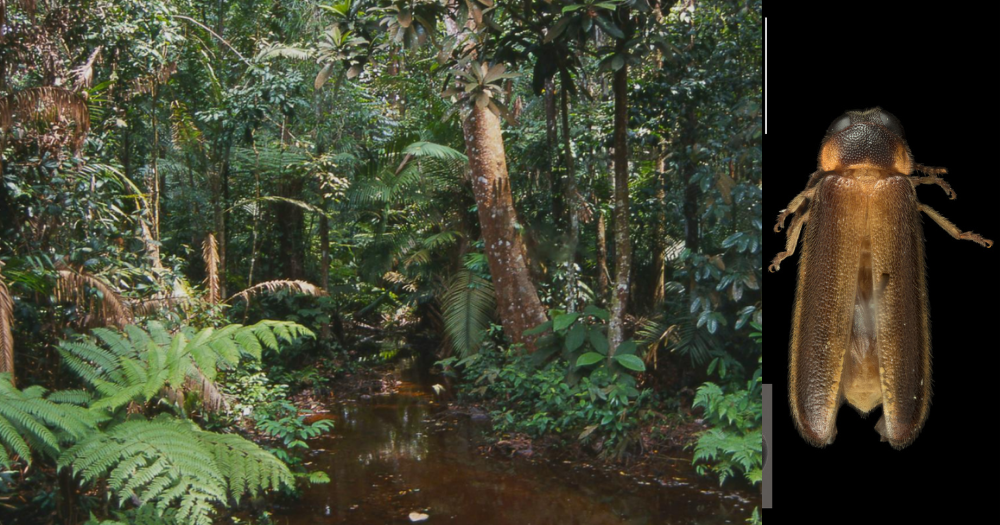Follow us on Telegram for the latest updates: https://t.me/mothershipsg
Researchers from the National University of Singapore (NUS) and National Parks Board (NParks) have discovered a new species of firefly at Nee Soon Swamp Forest in the Central Catchment Nature Reserve.
The Nee Soon Swamp Forest is the only remaining patch of primary freshwater swamp forest in Singapore.
It has been described as the "most important area in Singapore for native aquatic fauna and flora" in a 1992 paper by head of Lee Kong Chian Museum Peter Ng.
This marks the first time since 1909 that a new species of firefly has been discovered and it has been named as the Singapore firefly (Luciola singapura), according to the research paper published on Mar. 4, 2021.
New species first discovered in 1989
While Singapore is a highly urbanised city, fireflies have a scattered distribution and are not as uncommon as what we urban dwellers might assume.
In a 2009 nationwide survey of fireflies at 14 sites in Singapore, 11 species were documented, including the Singapore firefly, which was an unidentified species back then.
After examining the specimens at the Lee Kong Chian Natural History Museum (LKCNHM), the researchers found that firefly specimens collected in 1989 and 1990 from the same area were morphologically similar to Singapore firefly.
The researchers then went back to the same area at Nee Soon Swamp Forest to conduct night surveys in 2018 and 2019.
“When we first encountered this species, we knew it was interesting because the specimens were collected from a freshwater swamp forest in the central catchment area of Singapore—fireflies are rarely reported from this type of habitat. Furthermore, it did not fit the descriptions of any known firefly species to-date,” says Wan Faridah Akmal Jusoh, the lead author of the paper and Research Fellow at LKCNHM.
“We thought the specimens collected in 2009 were the only ones of the unidentified species until I started examining the firefly collection in LKCNHM and found three additional specimens collected 20 years prior. I immediately contacted my colleagues at NParks and we arranged a series of night surveys.”
Discovery made possible with modern techniques
Some 30 years since its initial discovery in 1989, the researchers are finally able to confirm that the Singapore firefly is genetically and morphologically distinct from other fireflies after conducting intricate dissections to examine internal organs of the fireflies and employed modern DNA techniques through a method called genome skimming.
“This study underscores the importance and utility of molecular methods that can provide solutions to problems that are otherwise difficult to resolve using traditional approaches,” explains Chan Kin Onn, co-author of the paper and a Museum Officer at LKCNHM.
More about Singapore firefly and their habitat
The Singapore firefly is a small species of less than 5mm long.
Their habitat is the swampy area with dense vegetation, damp leaf litter, and high soil moisture, the paper described.
The adults were observed to congregate within a very small area at a specific location, perched and flashing on a fern.
Some of them were also observed flying low while emitting flickering yellow flashes in the shrubs and at the fringe of the forest between 8pm to 10pm during the surveys.
However, no larvae were spotted.
Better understanding of its ecology and distribution is necessary
To date, Singapore has 14 species of fireflies identified, including the Singapore firefly.
Some species of fireflies have been spotted in various habitats such as primary and secondary forests, freshwater swamp, mangrove, grassland and scrublands.
More studies are needed to determine if the Singapore firefly is a freshwater swamp specialist.
While the Singapore firefly is found in a legally protected area, long-term protection of the species will require better understanding of its distribution and ecology, the researchers added.
The researchers also concluded that this discovery of a new species at Singapore's last remaining freshwater swamp forest highlights the importance of continued biodiversity research in Singapore and in the region.
Even a small, well-studied, and highly developed country such as Singapore can still harbour undescribed biodiversity, the researchers added.
On this note, Lim Liang Jim, Group Director of the National Biodiversity Centre at NParks said that this new discovery is "very significant to science in Singapore".
Lim added that under the NParks Nature Conservation Masterplan, NParks has a species recovery plan for Singapore fireflies and this discovery "will also contribute to the understanding of the species and ecology of fireflies in Singapore".
Top image via by Huge Tan Tiang Wah (left photo) and via (right photo)
If you like what you read, follow us on Facebook, Instagram, Twitter and Telegram to get the latest updates.

